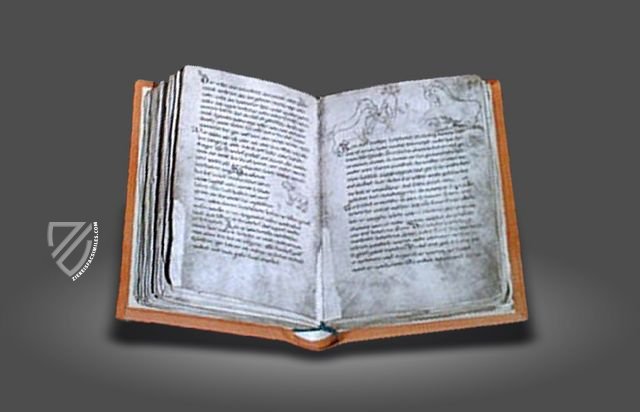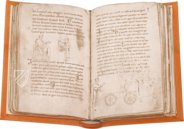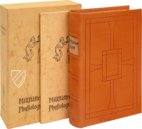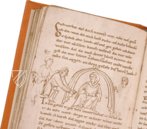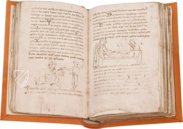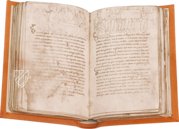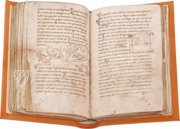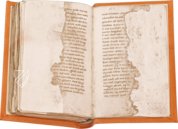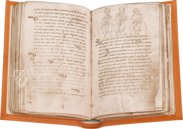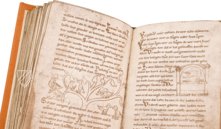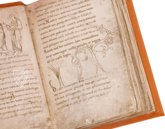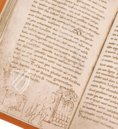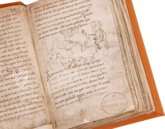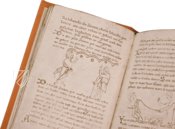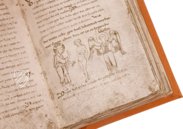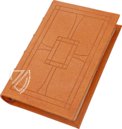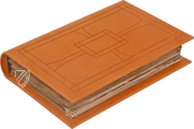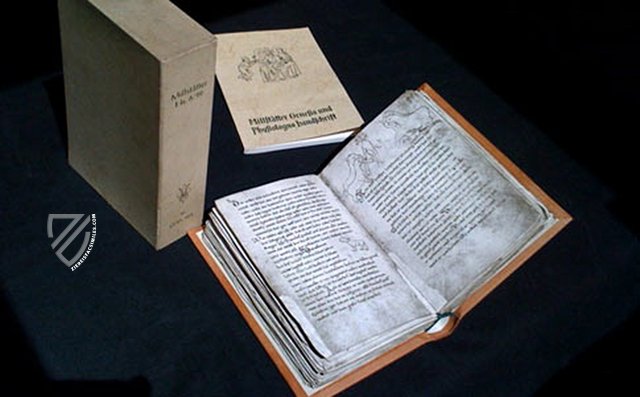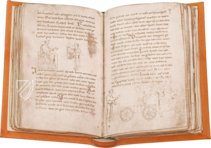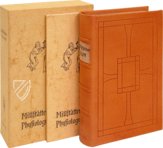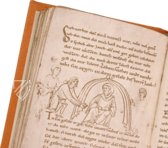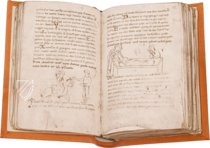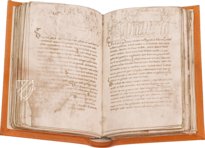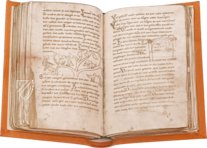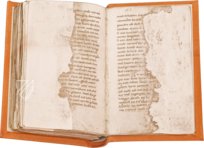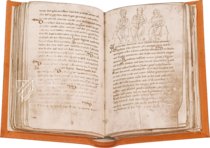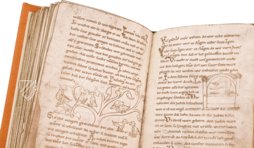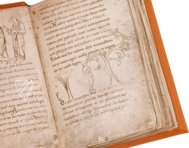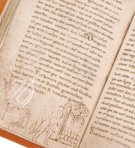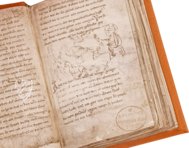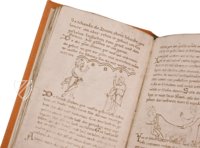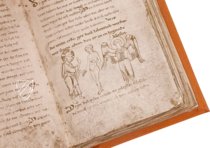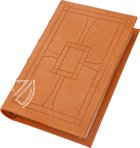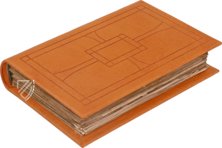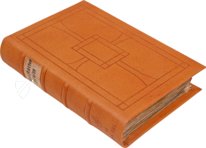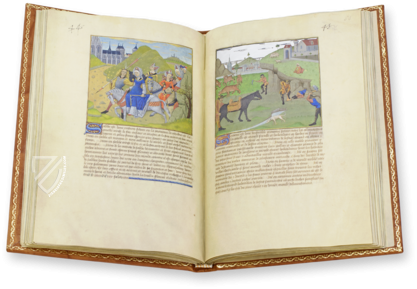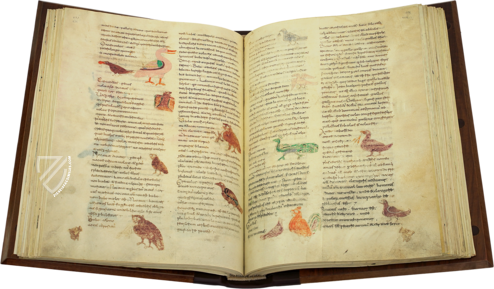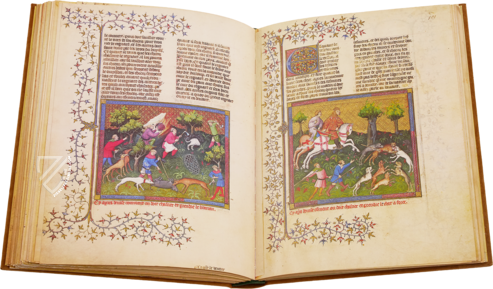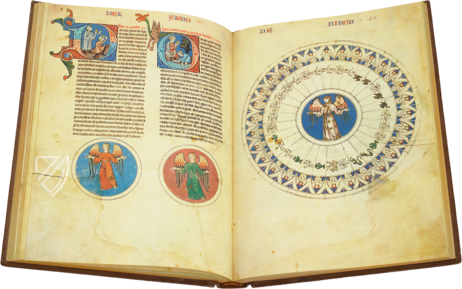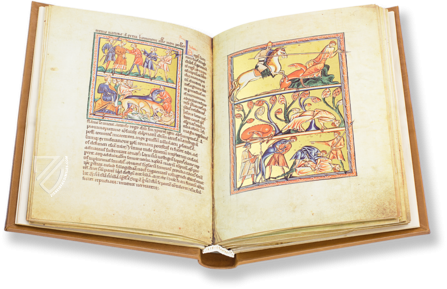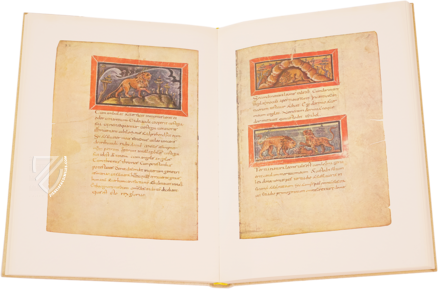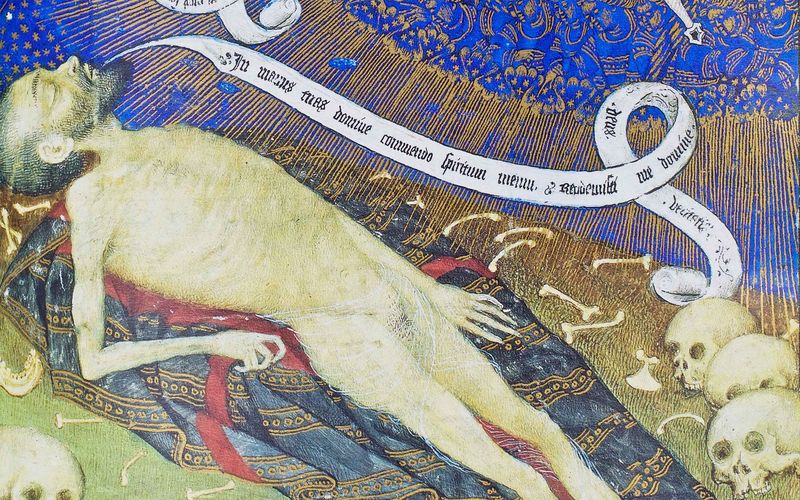Millstatt Genesis and Physiologus
8 rhyming poems in 6,062 verses – this is the so-called Millstatt Genesis and Physiologus manuscript: it is one of the most important of the Early Middle High German anthology manuscripts. It dates from ca. 1200 in southern Bavaria, although probably not from the namesake monastery of Millstatt in Upper Carinthia itself. The first section (fol. 1-84) is the most important text in terms of literary history, namely a free rhymed translation of the biblical book of Genesis into German. Also written in rhyme, the Millstatt Physiologus (fol. 84v–101) is a Christian moralizing textbook on zoology that describes 29 more or less real animal species. These two sections are illustrated with 119 finely colored pen and ink drawings. Due to cost considerations, the publisher had to forgo color reproductions of the 167 leaves in total. However, 8 true-color reproductions, which are included with the commentary volume, give a vivid impression of the delicate hues of the original.
Millstatt Genesis and Physiologus
It is not without reason that the Millstatt Genesis and Physiologus was added to the UNESCO Memory of Austria Register in 2022: it is one of the most important examples of Early Middle High German literature and language. The rhyming version of Genesis contained therein is of utmost significance: it is the youngest surviving Early Middle High German biblical poem in rhyming couplets. But that's not all – the manuscript is also the oldest extensively illuminated book in German and is therefore of particular art historical interest.
Biblical Rhymes and Animal Allegories
The codex, of which 167 parchment leaves have been preserved, was probably created around 1200 or sometime between 1050 and 1170 in Carinthia. The manuscript was therefore written in the South Bavarian Early Middle High German spoken there at the time and contains a total of eight vernacular poems.
The first three works make up the largest part of the manuscript: the so-called Millstatt Genesis is a free rhyming adaptation of the Book of Genesis, the so-called Millstatt Exodus translates the first 15 chapters of the Book of Exodus into Early Middle High German, and the so-called Millstatt Physiologus translates the moralizing teachings of the Latin textbook on zoology into German rhymes. Here, 29 animal species are described using Christian allegories in order to impart worldly wisdoms to the readers.
This is followed by two sermons on fidelity, justice, and truthfulness, as well as Christian courtship. The manuscript closes with a confession prayer, the so-called Millstatt Lamentation of Sins, a rhymed interpretation of the Lord's Prayer, and the opening verses of the poem Das himmlische Jerusalem (The Heavenly Jerusalem), which is only fragmentarily preserved on the last page.
The Oldest Illuminated German-Language Manuscript
This second largest collection of early medieval literature is remarkably illuminated with 119 fine pen and ink drawings in red, blue, and brown ink, accompanying the Genesis and the Physiologus. While the animal images enchant with their uniqueness, the Genesis miniatures are of particular art-historical value. The cycle preserves pictorial traditions that are otherwise only found in the Cotton Genesis fragments in the British Museum, in a mosaic dome in St. Mark's in Venice, and in the Genesis frontispieces of the Carolingian Bibles produced in Tours.
A Piece of Carinthian History
The medieval history of this important manuscript remains cloudy to this day. The first trace of its whereabouts is found not until 1598. In that year, the codex passed into the possession of the Millstatt Jesuit community as part of the inventory of the Benedictine monastery in Millstatt, as documented by a 17th-century ownership note. As it is one of the most important manuscripts formerly owned by the Millstatt monastery, the codex was named after this former location. After the Jesuit Order was abolished by Pope Clement XIV in 1773, the Millstatt Genesis and Physiologus came into the hands of a Carinthian citizen in 1845 and was eventually purchased by the Association for History and Regional Studies of Carinthia. The association handed over the valuable manuscript to the Carinthian State Archives for safe keeping. Thus, it may never have left its region of origin.
Codicology
- Alternative Titles
- Die Millstätter Genesis- und Physiologus-Handschrift
- Size / Format
- 344 pages / 20.0 × 13.0 cm
- Origin
- Austria
- Date
- Ca. 1200
- Epochs
- Style
- Language
- Script
- Protogothic minuscule
- Illustrations
- 119 pen-and-ink drawings in brown, red, and blue ink
- Content
- Millstatt Genesis (fol. 1r–84r), Physiologus in rhyme (fol. 84v–101r), Millstatt Exodus (fol. 101v–135r), Vom Recht (On Law) (fol. 135v–142r), Die Hochzeit (The Wedding) (fol. 142r–154v), Millstatt Lamentation of Sins (fol. 154v–164v), Millstatt Paternost
- Previous Owners
- Benedictine monastery of Millstadt
Jesuit community of Millstadt
Carinthian Association for History and Regional Studies
Millstatt Genesis and Physiologus
Abraham's Descendants
This seemingly simple pen and ink drawing shows a rare depiction of God (left) and Abraham (right) looking up at the sky and counting the stars. In Genesis 15:5, God instructs Abraham to do this, promising him as many descendants as he could count. In keeping with this powerful promise, God appears in the miniature in a flowing robe, standing upright and clearly larger than the frail and small-looking Abraham, who is leaning on a walking stick. Also noteworthy is the vaulted representation of the firmament, which corresponds to the medieval conception of heaven as a vault, dome, or tent.
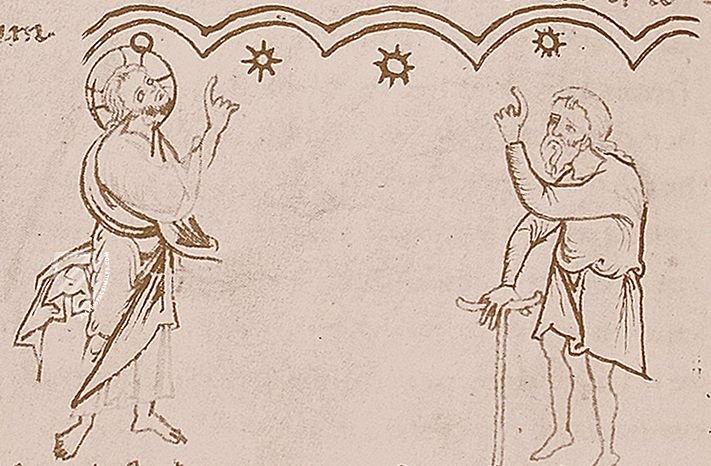
Millstatt Genesis and Physiologus
The Story of Abraham
The two pen-and-ink drawings on this page depict two significant events in the life of Abraham, described in Genesis 17 and 18. The upper drawing tells the story of his circumcision in two scenes: While on the left he receives the command from God, coming down from heaven, to circumcise himself, on the right he is shown seated, performing the act. In this way, Abraham enters into a covenant with God, who in turn promises him numerous descendants despite his advanced age of almost 100 years.
And indeed, one day three angels – messengers of God – appear to Abraham and his equally elderly wife Sarah. After he has welcomed them submissively, they ask for Sarah and promise the couple the miraculous news that she will soon give birth to a son who will be named Isaac. The miniature shows them standing completely taken aback at the entrance to their tent, while Abraham falls to his knees. The middle of the three angels wears a cross halo, identifying him as God himself.
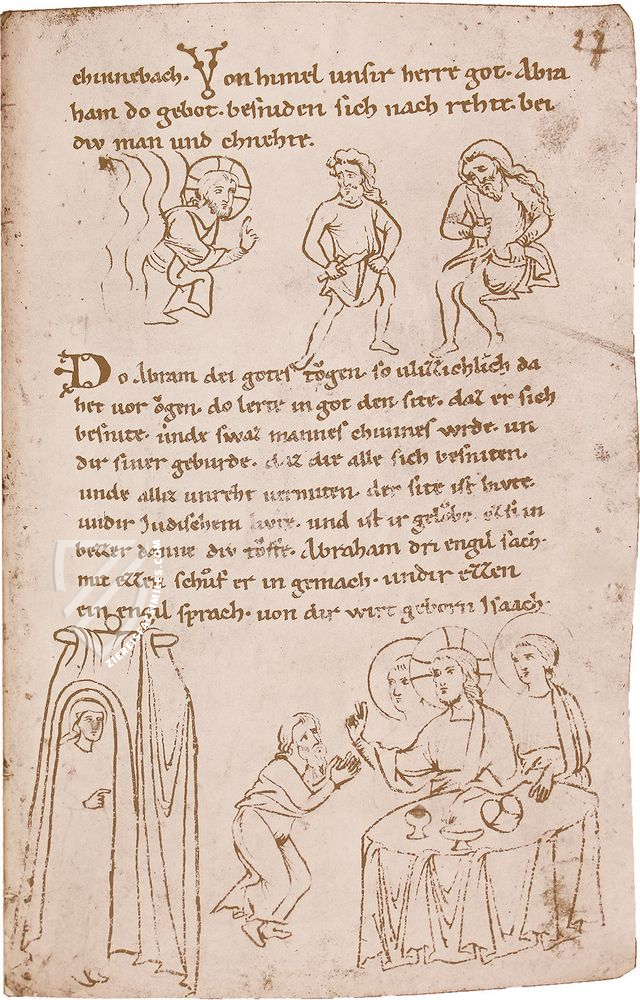
#1 Die Millstätter Genesis- und Physiologus-Handschrift
Language: German
- Treatises / Secular Books
- Apocalypses / Beatus
- Astronomy / Astrology
- Bestiaries
- Bibles / Gospels
- Chronicles / History / Law
- Geography / Maps
- Saints' Lives
- Islam / Oriental
- Judaism / Hebrew
- Single Leaf Collections
- Leonardo da Vinci
- Literature / Poetry
- Liturgical Manuscripts
- Medicine / Botany / Alchemy
- Music
- Mythology / Prophecies
- Psalters
- Other Religious Books
- Games / Hunting
- Private Devotion Books
- Other Genres
- Afghanistan
- Armenia
- Austria
- Belgium
- Belize
- Bosnia and Herzegovina
- China
- Colombia
- Costa Rica
- Croatia
- Cyprus
- Czech Republic
- Denmark
- Egypt
- El Salvador
- Ethiopia
- France
- Germany
- Greece
- Guatemala
- Honduras
- Hungary
- India
- Iran
- Iraq
- Israel
- Italy
- Japan
- Jordan
- Kazakhstan
- Kyrgyzstan
- Lebanon
- Liechtenstein
- Luxembourg
- Mexico
- Morocco
- Netherlands
- Palestine
- Panama
- Peru
- Poland
- Portugal
- Romania
- Russia
- Serbia
- Spain
- Sri Lanka
- Sweden
- Switzerland
- Syria
- Tajikistan
- Turkey
- Turkmenistan
- Ukraine
- United Kingdom
- United States
- Uzbekistan
- Vatican City
- A. Oosthoek, van Holkema & Warendorf
- Aboca Museum
- Ajuntament de Valencia
- Akademie Verlag
- Akademische Druck- u. Verlagsanstalt (ADEVA)
- Aldo Ausilio Editore - Bottega d’Erasmo
- Alecto Historical Editions
- Alkuin Verlag
- Almqvist & Wiksell
- Amilcare Pizzi
- Andreas & Andreas Verlagsbuchhandlung
- Archa 90
- Archiv Verlag
- Archivi Edizioni
- Arnold Verlag
- ARS
- Ars Magna
- ArtCodex
- AyN Ediciones
- Azimuth Editions
- Badenia Verlag
- Bärenreiter-Verlag
- Belser Verlag
- Belser Verlag / WK Wertkontor
- Benziger Verlag
- Bernardinum Wydawnictwo
- BiblioGemma
- Biblioteca Apostolica Vaticana (Vaticanstadt, Vaticanstadt)
- Bibliotheca Palatina Faksimile Verlag
- Bibliotheca Rara
- Boydell & Brewer
- Bramante Edizioni
- Bredius Genootschap
- Brepols Publishers
- British Library
- C. Weckesser
- Caixa Catalunya
- Canesi
- CAPSA, Ars Scriptoria
- Caratzas Brothers, Publishers
- Carus Verlag
- Casamassima Libri
- Centrum Cartographie Verlag GmbH
- Chavane Verlag
- Christian Brandstätter Verlag
- Circulo Cientifico
- Club Bibliófilo Versol
- Club du Livre
- CM Editores
- Collegium Graphicum
- Collezione Apocrifa Da Vinci
- Comissão Nacional para as Comemorações dos Descobrimentos Portugueses
- Coron Verlag
- Corvina
- CTHS
- D. S. Brewer
- Damon
- De Agostini/UTET
- De Nederlandsche Boekhandel
- De Schutter
- Deuschle & Stemmle
- Deutscher Verlag für Kunstwissenschaft
- DIAMM
- Droz
- E. Schreiber Graphische Kunstanstalten
- Ediciones Boreal
- Ediciones Grial
- Ediclube
- Edições Inapa
- Edilan
- Editalia
- Edition Deuschle
- Edition Georg Popp
- Edition Leipzig
- Edition Libri Illustri
- Editiones Reales Sitios S. L.
- Éditions de l'Oiseau Lyre
- Editions Medicina Rara
- Editorial Casariego
- Editorial Mintzoa
- Editrice Antenore
- Editrice Velar
- Edizioni Edison
- Egeria, S.L.
- Eikon Editores
- Electa
- Emery Walker Limited
- Enciclopèdia Catalana
- Eos-Verlag
- Ephesus Publishing
- Ernst Battenberg
- Eugrammia Press
- Extraordinary Editions
- Fackelverlag
- Facsimila Art & Edition
- Facsimile Editions Ltd.
- Facsimilia Art & Edition Ebert KG
- Faksimile Verlag
- Feuermann Verlag
- Folger Shakespeare Library
- Franco Cosimo Panini Editore
- Friedrich Wittig Verlag
- Fundación Hullera Vasco-Leonesa
- G. Braziller
- Gabriele Mazzotta Editore
- Gebr. Mann Verlag
- Gesellschaft für graphische Industrie
- Getty Research Institute
- Giovanni Domenico de Rossi
- Giunti Editore
- Graffiti
- Grafica European Center of Fine Arts
- Guido Pressler
- Guillermo Blazquez
- Gustav Kiepenheuer
- H. N. Abrams
- Harrassowitz
- Harvard University Press
- Helikon
- Hendrickson Publishers
- Henning Oppermann
- Herder Verlag
- Hes & De Graaf Publishers
- Hoepli
- Holbein-Verlag
- Houghton Library
- Hugo Schmidt Verlag
- Idion Verlag
- Il Bulino, edizioni d'arte
- ILte
- Imago
- Insel Verlag
- Insel-Verlag Anton Kippenberger
- Instituto de Estudios Altoaragoneses
- Instituto Nacional de Antropología e Historia
- Introligatornia Budnik Jerzy
- Istituto dell'Enciclopedia Italiana - Treccani
- Istituto Ellenico di Studi Bizantini e Postbizantini
- Istituto Geografico De Agostini
- Istituto Poligrafico e Zecca dello Stato
- Italarte Art Establishments
- Jan Thorbecke Verlag
- Johnson Reprint Corporation
- Josef Stocker
- Josef Stocker-Schmid
- Jugoslavija
- Karl W. Hiersemann
- Kasper Straube
- Kaydeda Ediciones
- Kindler Verlag / Coron Verlag
- Kodansha International Ltd.
- Konrad Kölbl Verlag
- Kurt Wolff Verlag
- La Liberia dello Stato
- La Linea Editrice
- La Meta Editore
- Lambert Schneider
- Landeskreditbank Baden-Württemberg
- Leo S. Olschki
- Les Incunables
- Liber Artis
- Library of Congress
- Libreria Musicale Italiana
- Lichtdruck
- Lito Immagine Editore
- Lumen Artis
- Lund Humphries
- M. Moleiro Editor
- Maison des Sciences de l'homme et de la société de Poitiers
- Manuscriptum
- Martinus Nijhoff
- Maruzen-Yushodo Co. Ltd.
- MASA
- Massada Publishers
- McGraw-Hill
- Metropolitan Museum of Art
- Militos
- Millennium Liber
- Müller & Schindler
- Nahar - Stavit
- Nahar and Steimatzky
- National Library of Wales
- Neri Pozza
- Nova Charta
- Oceanum Verlag
- Odeon
- Orbis Mediaevalis
- Orbis Pictus
- Österreichische Staatsdruckerei
- Oxford University Press
- Pageant Books
- Parzellers Buchverlag
- Patrimonio Ediciones
- Pattloch Verlag
- PIAF
- Pieper Verlag
- Plon-Nourrit et cie
- Poligrafiche Bolis
- Presses Universitaires de Strasbourg
- Prestel Verlag
- Princeton University Press
- Prisma Verlag
- Priuli & Verlucca, editori
- Pro Sport Verlag
- Propyläen Verlag
- Pytheas Books
- Quaternio Verlag Luzern
- Reales Sitios
- Recht-Verlag
- Reichert Verlag
- Reichsdruckerei
- Reprint Verlag
- Riehn & Reusch
- Roberto Vattori Editore
- Rosenkilde and Bagger
- Roxburghe Club
- Salerno Editrice
- Saltellus Press
- Sandoz
- Sarajevo Svjetlost
- Schöck ArtPrint Kft.
- Schulsinger Brothers
- Scolar Press
- Scrinium
- Scripta Maneant
- Scriptorium
- Shazar
- Siloé, arte y bibliofilia
- SISMEL - Edizioni del Galluzzo
- Sociedad Mexicana de Antropología
- Société des Bibliophiles & Iconophiles de Belgique
- Soncin Publishing
- Sorli Ediciones
- Stainer and Bell
- Studer
- Styria Verlag
- Sumptibus Pragopress
- Szegedi Tudomànyegyetem
- Taberna Libraria
- Tarshish Books
- Taschen
- Tempus Libri
- Testimonio Compañía Editorial
- Thames and Hudson
- The Clear Vue Publishing Partnership Limited
- The Facsimile Codex
- The Folio Society
- The Marquess of Normanby
- The Richard III and Yorkist History Trust
- Tip.Le.Co
- TouchArt
- TREC Publishing House
- TRI Publishing Co.
- Trident Editore
- Tuliba Collection
- Typis Regiae Officinae Polygraphicae
- Union Verlag Berlin
- Universidad de Granada
- University of California Press
- University of Chicago Press
- Urs Graf
- Vallecchi
- Van Wijnen
- VCH, Acta Humaniora
- VDI Verlag
- VEB Deutscher Verlag für Musik
- Verlag Anton Pustet / Andreas Verlag
- Verlag Bibliophile Drucke Josef Stocker
- Verlag der Münchner Drucke
- Verlag für Regionalgeschichte
- Verlag Styria
- Vicent Garcia Editores
- W. Turnowski Ltd.
- W. Turnowsky
- Waanders Printers
- Wiener Mechitharisten-Congregation (Wien, Österreich)
- Wissenschaftliche Buchgesellschaft
- Wissenschaftliche Verlagsgesellschaft
- Wydawnictwo Dolnoslaskie
- Xuntanza Editorial
- Zakład Narodowy
- Zollikofer AG

